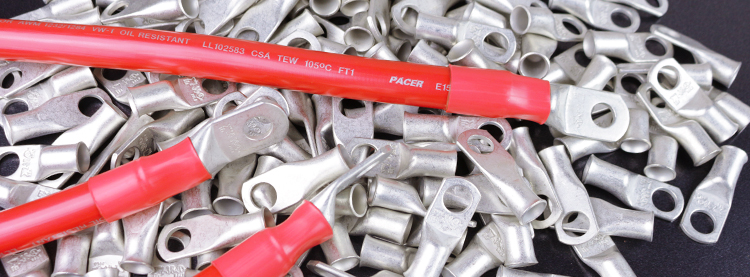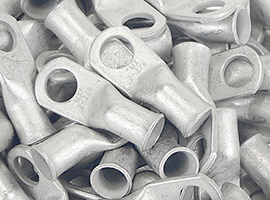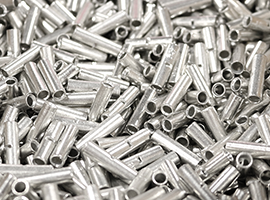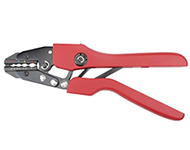Categories
- Wire & Cable
- Multi-conductor & Signal Cable
- Battery Cable Assemblies
- Terminals and Connectors
- Electrical Parts
- Electrical Tools
- ID Products
- Wire Management
- Tape & Sealant
- Mounting Panels & Panel Blanks

Need Help?
Click HereGet a Business Account
Apply HereLugs & Splices

What are lugs and splices?
Lugs and splices are electrical wire connectors that are created by crimping the connector onto a wire or cable. This connection, commonly referred to as a cold weld, creates a solid, long-lasting connection. Pacer lugs and splices are made from 100% pure copper for high conductivity. This copper is fully annealed to prevent cracking while being crimped and while in service. This means that these connectors are designed for long term applications. These types of crimp connectors are also tinned plated to prevent corrosion which adds to their longevity. Many of these Lugs are general purpose seamless electrical terminals. They are commonly used with battery cable, primary wire, or other types of electrical cables. When used, they create a superior hold and are designed specifically for demanding environments.
"These terminals are also tinned plated to prevent corrosion which adds to their longevity."
Butt splices are a type of connector that are commonly used to join two or more wires. They carry an internal indent so that the wires can be lined up perfectly. Some butt splices are meant to connect a single wire to multiple wires whereas others are designed to connect wires of various sizes. Butt splices are known for their ease of use and longevity. One question we often get is about the difference between a lug and a splice.
Where are these products implemented?

Lugs are ideal for a range of applications
Lugs and butt splices are implemented in larger gauge applications, typically 8 gauge cable and greater. These types of crimp connectors are some of the most durable terminals you will find. Although they are designed for new installations, lugs and buttsplices work equally well as replacement parts. In order to properly install them, you will need to use the proper tools and a heat shrink would be useful as well. Lugs and splices are crimp connectors that are designed with longevity, versatility, and durability in mind. Now that we have covered some of the basics, let us take a look at the differences between a lug and a splice.
What is the difference between a lug and a splice?
Lugs and splices carry several distinct differences that separate them from one another. For starts, splices are the same on both ends of the connector. This does not hold true for lugs. Lugs carry a ring terminal opening on one side of the connector. Remember, splices are for wire-to-wire applications, whereas lugs are for wire to post or screw applications. A splice also carries an internal indentation for the wires to butt up against whereas a lug has a closed interior. A lug is used for very different applications than a splice would be and vice versa. It is important to understand the applications that these connectors are best suited for.
![]()
A Lug
![]()
A Splice
What types of lugs are available?
 Closed end
Closed end
Closed end lugs are used in applications where ring terminals do not offer the needed protection. Creating a strong connection is essential to every electrical system and closed end lugs offer a high level of protection. By using closed end lugs, you get not only durability but longevity as well even in tough environments. These wire connectors are built tough. Pacer's closed end lugs carry a tin plating and have no exposed seams. This makes them ideal for marine applications. What makes them ideal for the marine environment is the fact that they can be used to create waterproof connections. When lugs are used with epoxy heat shrink, the closed end lug will fully envelop the conductor leaving no room for moisture to accumulate. This leaves nothing exposed to the elements.
 Brazed seam
Brazed seam
Brazed seam lugs are similar to lugs but instead of a closed end, they carry an open face barrel. Non-insulated brazed seam tinned lugs create long-lasting, durable electrical connections and come in a variety of gauge sizes and stud sizes to handle nearly any task. Pacer offers non-insulated brazed seam tinned lugs in wire sizes 8 AWG to 4/0 AWG so that you find exactly what you need. The available stud sizes include #10, 1/4", 5/16", 3/8" as well as 1/2". These lugs are made from copper that has been tinned to provide excellent protection in the toughest conditions. In this way, they are already corrosion resistant making one less thing you must worry about. This makes them perfect for use in the marine environment.
What types of splices are available?
 Heat shrink
Heat shrink
Heat shrink butt splices offer the highest level of protection possible. They create a moisture proof environmental seal. They achieve this through the epoxy lining that they carry inside. As the high shrink is heated, the inner glue melts and pushes out creating a durable barrier. In this way, heat shrink butt splices are the ideal solution for the marine environment.
 Step down
Step down
Step down butt splices are designed to be used with wires of various sizes. This means that each side of the terminal has a different diameter in order to accommodate the different wires. So, a 12-10 step down butt splice is designed to be used with a 12 AWG wire on one side and a 10 AWG wire on the other side. They can also be used with multiple wires of smaller sizes.
 Seamless tinned
Seamless tinned
Seamless tinned butt splices are built from a single smooth piece of copper that has been tinned. They carry no insulation whatsoever. Their seamless nature gives the body added strength as a seam can be considered to be the weakest point on a butt splice. Seamless tinned butt splices are ideal for internal components where the connection point will not be exposed to the elements.
 Seamless barrel
Seamless barrel
Seamless barrel butt splices are very similar to seamless tinned butt splices. Both are tinned copper however, seamless barrel butt splices are available in both non-insulated as well as insulated. They can be found in both nylon and vinyl insulations making them ideal for specific applications depending on the needs of your job. One great aspect of these connectors is the corrosion resistance that they get from their tin plating.
Where would I use lugs?

Lugs can be used anywhere you need an electrical cable to terminate on a stud. By installing electrical connectors onto the end of a cable, you allow that cable to be quickly and easily installed. We carry the electrical connector types that you have been looking for. The central hole on the pad is sized to fit snuggly over various stud sizes helping to create a solid connection. Lugs are like super powered ring terminals that can handle the toughest marine environment and just about any task that you can throw at it. They can be used in just about any job site, marina, repair shop, or private garage.
Where would I use butt splices?

Butt splices can be used to connect two wires together or even multiple wires on each side. Say for instance, you need to repair a damaged wire on a ship. That wire goes into the hull and all throughout the vessel. Replacing the entire wire would be costly and time consuming. If you use an epoxy lined heat shrink butt splice you can remove the damaged section of wire and reconnect the remaining wire with the splice. They are so useful that we recommend always keeping a few one hand on your vessel.
What tools should I use with lugs and splices?
Both lugs and splices can be crimped using the same tools. For the vast majority of these terminals, you can use our VTTR50 which can crimp terminals from 22 AWG all the way to 8 AWG. This production crimper is a smart choice for its repeatability and reliability. Another solid tool is our VT3120CT. This tool can work with terminals from 22 AWG to 10 AWG. Both of these tools use a ratcheting action to ensure the exact crimp pressure each and every time. We carry a whole host of tools from crimpers and cutters, to strippers and heat tools. We even have a line of specialty tools available. To see what other tools we have available, click here.
Does the insulation type really matter?
The type of insulation of your terminal plays a crucial role in the function and performance of your electrical connection. Heat shrink offers the highest level of protection and can be used in just about any environment. Nylon insulation offers a high level of protection as well and the semitransparent insulation makes proper crimp identification a simple task. The next step down is vinyl insulation which offers a solid level of protection. The most cost-effective option is the non-insulated. Each of these types offers its own unique specialty in the right conditions. The trick is knowing when to use each type

What industries use Pacers lugs?
Pacer’s lugs are used in a range of industries from automotive to marine. You will also find them in use on industrial job sites, in heavy machinery, in marinas, repair shops, and even private garages. They are found in so many industries due to their reliable, solid design and their long-term durability. One reason they are so trusted in the fact that they can handle the harshest marine environments out there making them a staple in just about every boat builder’s arsenal.
Why choose Pacer?
Pacer has over forty years in the marine industry and is a supplier and manufacturer for some of the world’s largest boat builders. Our wire and cable have earned the respect of OEMs and boating enthusiasts alike. With a dedication to service and customer satisfaction, Pacer has built a reputation to be trusted. When you see Pacer you know that you have quality.
*This page was updated on 2/07/2023*






